Celebrating 75 Years of Great Meetings Highlights from TVA’s Annual Meeting in San Diego
The 75th Annual Meeting of TVA was a resounding success. It brought together industry professionals from across the world to celebrate the organization’s achievements and learn about the latest trends and developments in the field.
The meeting was held in San Diego, California from April 23 to 25, 2024, and it was an amazing event featuring valuable education and networking opportunities.
TVA’s Annual Meeting is renowned for its commitment to education, and this year was no different. Attendees had the privilege to delve into a diverse range of topics, including “Navigating the Artificial Intelligence Landscape,” “The Carbon Footprint of Vermiculite,” and “Process Monitoring.” These informative sessions were delivered by experts in the field, Dr. Henrik Christensen and Chuck Vogelsang.
The Annual Meeting also featured a Mining Panel, an Exfoliator Panel, and a President’s Roundtable. These sessions gave attendees insights into the latest industry trends and developments and allowed for valuable Q&A and discussions.
One of the highlights of the event was the 75th Anniversary Reception and Dinner, which provided a great opportunity to celebrate the organization’s history and success. We are grateful to all the attendees, presenters, and sponsors who helped make it possible.
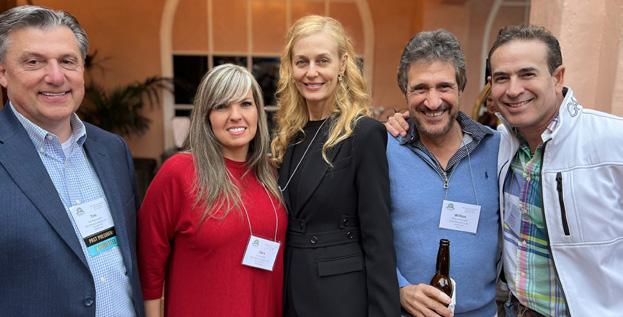


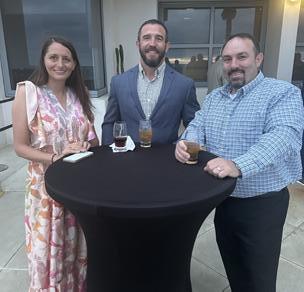
1 LIGHTWEIGHT NEWS THE QUARTERLY
THE VERMICULITE ASSOCIATION Collaborating to promote vermiculite. Encouraging and promoting best practices. Dedicated to safety, integrity and honesty. SPRING 2024
NEWSLETTER OF
Continued on next page....

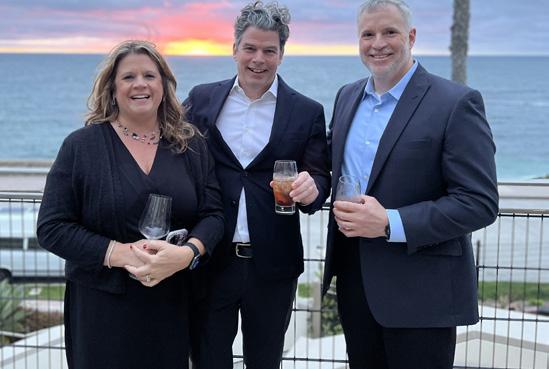
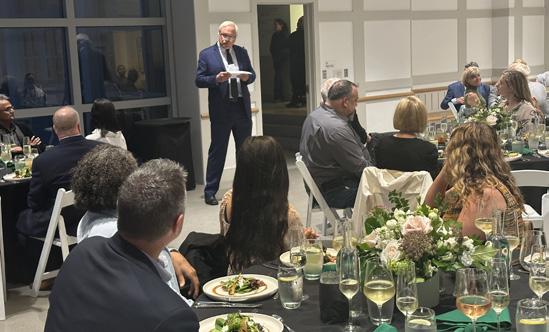
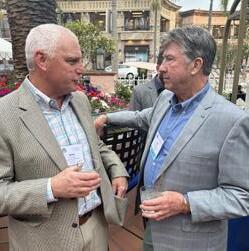



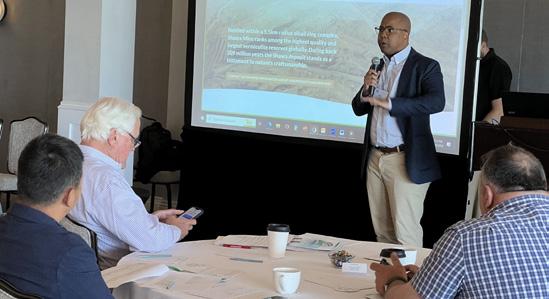
Lastly, we want to express our deepest gratitude to our sponsors, Palabora Global, The Strong Company, Inc., Virginia Vermiculite LLC, and Whitemore Company, Inc. Your support not only makes events like the Annual Meeting possible, but it also underscores the value of our partnership. We are truly grateful for your continued support and collaboration.

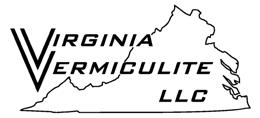

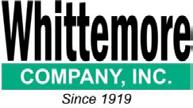
2 LIGHTWEIGHT NEWS - SPRING 2024
75 Meetings! Wow!
TVA Commemorates Anniversary with Digital Time Capsule
In April, TVA marked an impressive milestone – its 75th meeting. During the event attendees and staff celebrated our industry’s heritage, progress, and future. Please take a moment to enjoy the pictures from TVA meetings over the years and follow this link to view the Digital Time Capsule, which features our members and staff commemorating the anniversary, sharing favorite memories and talking about what TVA means to them. They capture the spirit of camaraderie and innovation that defines our community.
Looking back at the Vermiculite Association’s journey, our collective efforts have significantly contributed to the industry’s growth and sustainability. The 75th meeting provided a valuable opportunity to honor the pioneers, acknowledge the milestones, and envision the possibilities.
As we celebrate this momentous occasion, it’s essential to recognize the contributions of every individual who has been part of this extraordinary journey. Their commitment and expertise have been instrumental in shaping the success of TVA.
We are poised to embrace new challenges, leverage innovative technologies, and foster global collaborations in the coming years. The 75th meeting of the Vermiculite Association was a testament to our resilience, unity, and unwavering commitment to excellence.
Here’s to the next 75 years of continued growth and prosperity!



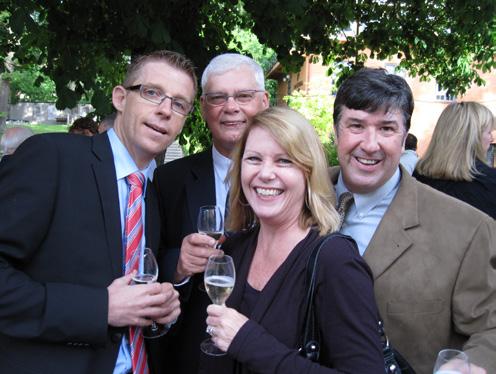

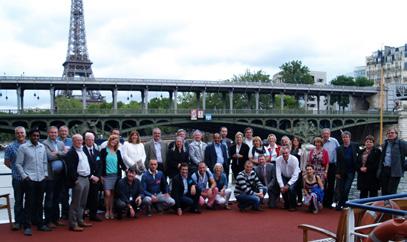

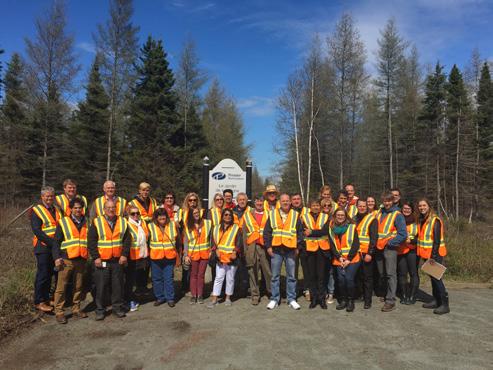
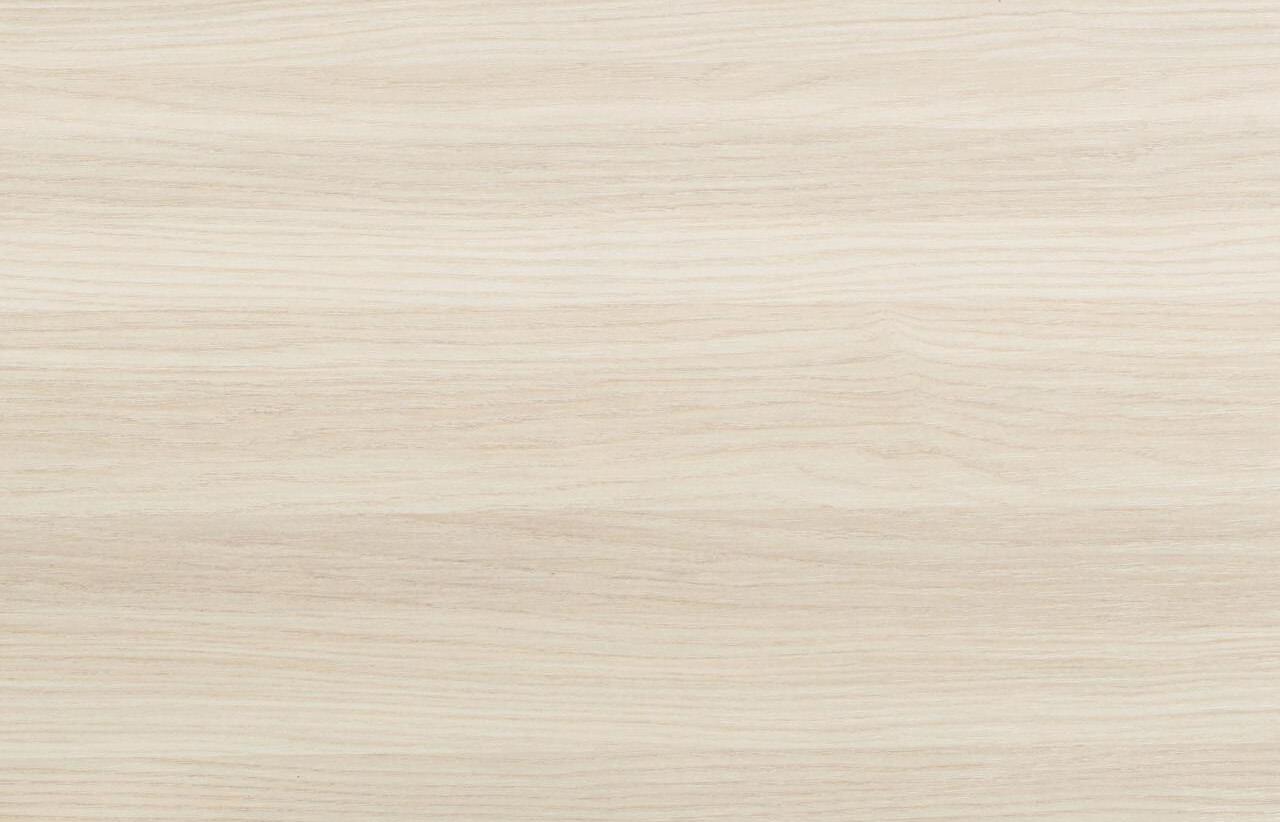
LIGHTWEIGHT NEWS - SPRING 2024
Jeffrey Sheehy Completes His Term as TVA President
At TVA’s Annual Meeting earlier this year, Jeffrey Sheehy completed his role as President of the Board of Directors.
Jeffrey joined our Board in November 2012, stepping in mid-term with a passion for our mission and a determination to make a difference. His early years on the Board were marked by his active engagement and insightful contributions, setting the stage for his future leadership roles.
In 2021, Jeffrey’s unwavering dedication earned him the position of Vice President, a role he embraced wholeheartedly. His tenure as VP from 2021 to 2022 was instrumental in navigating the association through the post-COVID era. His collaborative spirit laid a strong foundation for his subsequent role as President.
Taking the helm as President of the Board in 2022, Jeffrey’s leadership was characterized by an inclusive approach. Under his guidance, the association fostered stronger industry relationships, especially as TVA members sorted through the new requirement by the EPA for reporting and recordkeeping for asbestos under the Toxic Substances Control Act (TSCA).
Even as his term as President concludes, Jeffrey’s commitment to TVA remains steadfast. He continues to serve on the Board as the immediate past president, a role he will fulfill until the Annual Meeting in 2026. His ongoing presence ensures a seamless transition and continuity of leadership, providing valuable insights and support to his successors.
Jeffrey’s journey with the trade association is a testament to his dedication, leadership, and passion for our industry. As we celebrate his contributions, we also look forward to his continued involvement and guidance in the years to come.
Message From the President
by Matt Goecker

We wrapped up our annual event in La Jolla, Calif. (San Diego) a few weeks ago, and I have to say it was a successful meeting. It was an appropriate venue to commemorate the 75th anniversary of TVA. Attendance and participation were strong, culminating with the annual dinner looking over the Pacific Ocean.
I am honored to be assuming the role of TVA President going forward. I would be remiss if I did not point out all those who came before me. Jeffrey Sheehy (Whittemore Company) has been an advocate for TVA and the vermiculite industry for over 30 years. His time as TVA President saw the formal requirements for asbestos reporting begin under the Toxic Substances Control Act (TSCA). While this exercise seems onerous for our membership (and the marketplace in general), it should help us further highlight the safety of the vermiculite
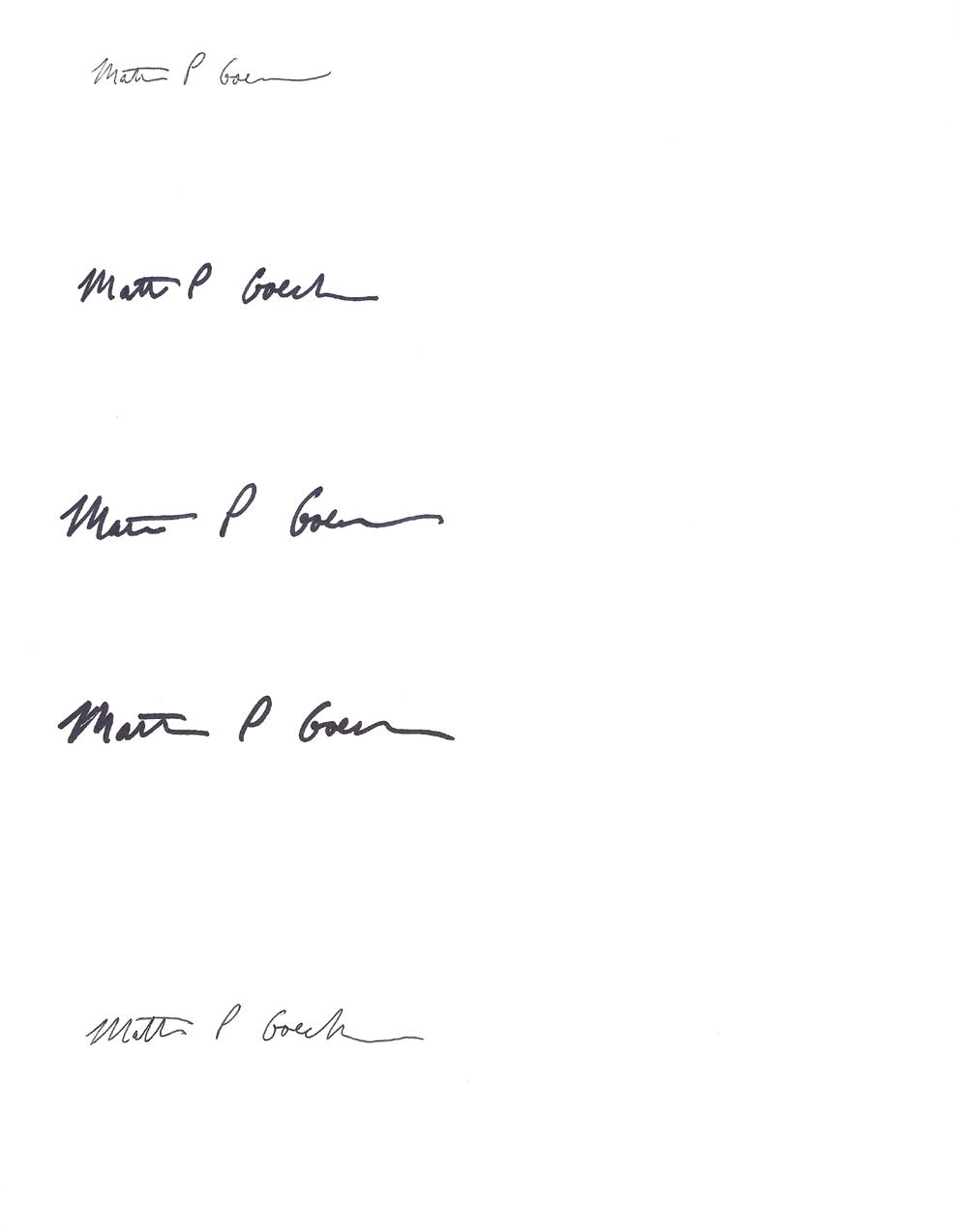
LIGHTWEIGHT NEWS - SPRING 2024
Leading the Way
An Interview with Matt Goecker, Board President of the Vermiculite Association
Matt Goecker, a passionate and committed industry professional, has recently been elected as the Board President of the Vermiculite Association. His dedication to the organization and its goals is evident as he shares his thoughts on his new role and the association’s future. Lightweight News recently sat down with Matt to discuss his upcoming presidential term.
Matt joined Dicalite Management Group in 2018 as Vice President of Global Sales and Marketing. He is responsible for the company’s commercial, customer support, and logistics groups. He is headquartered in Reno, Nevada.
“The company has about 400 employees and serves over 1,000 customers across more than 100 different end-market uses and applications worldwide,” he said.
His experience spans many different minerals, including diatomaceous earth, perlite, vermiculite, kaolin clay, calcium carbonate, bentonite, attapulgite and feldspar. Matt attended the University of Vermont and holds a B.S. and M.S. in Agricultural and Resource Economics.


When asked about his vision for advancing the goals of the Vermiculite Association during his tenure, Matt stressed the importance of evaluating the organization’s mission and goals to ensure alignment with the organization’s overall aims. He acknowledged the significant challenge the board faces in addressing the EPA regulatory environment due to vermiculite’s historical association with asbestos.
Matt also highlighted the importance of engaging and collaborating with TVA members, particularly through the Annual Meeting. He emphasized the need to plan a fantastic Annual Meeting with activities and content relevant to members’ day-to-day experiences.
“This event faced some challenges during the COVID-19 pandemic,” Matt said, “but it has successfully bounced back in the last two years, with great participation from our membership.”
Additionally, he looks forward to ongoing outreach to members and developing strategies for growing the membership.
5
on next page... LIGHTWEIGHT NEWS - SPRING 2024
Continued
As a crucial aspect of member engagement, he sees advocacy as a primary task ahead. “There is a significant focus on keeping members informed about current regulations and how we must respond to them as a collective and as individual companies. This is a crucial aspect of how we engage our membership,” he said.
“My goal is to enhance the organization’s image, especially considering the current challenging regulatory environment, particularly with EPA regulations and reporting.“
Regarding future trends and developments in vermiculite production, processing, and utilization, Matt discussed the potential for exploring more energy-efficient processing techniques and expanding the market for vermiculite applications. He noted the Vermiculite Association’s strong emphasis on identifying the new primary applications for vermiculite, particularly in fire and heat-related technologies.
As he assumed the role of Board President, Matt conveyed his gratitude for the opportunity to serve the organization. “A leadership position gives you some sense of pride and accomplishment, and that you’ve gotten to a level within that respective peer group or colleague group that is recognized,” he said.
Beyond his professional commitments, Matt shared insights into his personal life, revealing his active outdoor lifestyle, including skiing, golfing, walking, hiking, and biking. He also mentioned his two children, his appreciation for his community, which has strong roots on the East Coast, and a potential plan to retire there. Matt’s devotion to his hometown Philadelphia sports teams remains unwavering.
To stay current, Matt mentioned his involvement in organizations like the TVA and the Perlite Institute, highlighting their role in his professional development.
Matt Goecker’s election as the Board President of the Vermiculite Association brings a wealth of experience, dedication, and a clear vision for advancing the organization’s goals and engaging its members. Matt is poised to lead the Vermiculite Association to new heights with a focus on addressing regulatory challenges, enhancing the organization’s image, and fostering collaboration.
TVA Board of Directors
President – Matt Goecker Specialty Vermiculite, Bala Cynwyd, Pa. 775-287-9796
mgoecker@dicalite.com
Term expires 2026
Vice President – Vacant
Treasurer – Dan Metz Virginia Vermiculite, Louisa, Va. 540-967-2266
dan@virginiavermiculite.com
Term expires 2026
Immediate Past President – Jeffrey Sheehy, Sr. Whittemore Co. Inc., Lawrence, Ma. 978-681-8833
jsheehy@whittemoreco.com
Term expires 2026
Director – Tim DeJarnette
The Strong Company, Pine Bluff, AR (870) 535-7617
timdejarnette@strongseal.com
Term expires 2027
Director – Michael Dunlavey P.V.P. Industries, North Bloomfield, OH (440) 685-4701
mike@pvpind.com
Term expires 2027
Director – Jim Juron Traxys North America, New York, NY 10171 (201) 302-0888
jim.juron@traxys.com
Term expires 2026
Director – Rene van der Mark Isoleermaterialenindustrie Pull B.V., Netherlands +31 318 47 1001
rvandermark@pull.nl
Term expires 2027
6
LIGHTWEIGHT NEWS - SPRING 2024


From the Desk of Your Technical Consultant
The Latest News, Observations and Insights Into the World of Vermiculite
by Mike Darling
News from Kenya: Unlocking the Potential of
Vermiculite
in Kitengela, Kajiado County, Kenya
The Flag of Kajiado County
Nestled within the Kitengela Juakali Artisan Association Worksite is Shamba Vermiculite Limited, a pioneering company in the extraction and processing of vermiculite, a natural mineral abundant in the Makueni region of Kenya. Established in 2012 by the visionary Mr. Johnson Mwangangi, the company has become a cornerstone in delivering high-quality vermiculite products to various industries.
Vermiculite is a natural mineral whose versatility has wide-ranging applications. The expanded vermiculite produced by Shamba Vermiculite is primarily utilized as an exceptional insulating material, effectively regulating temperature and providing energy-efficient solutions. In horticulture, vermiculite contributes significantly to the success of propagation, seedlings, and overall plant growth. Additionally, it finds application as a lightweight aggregate in construction materials, enhancing structural integrity without compromising weight.
Read the story HERE; further insight into this story is found on Instagram
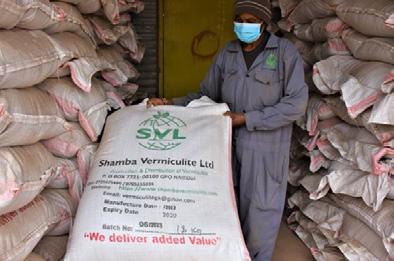

7
Continued on next page...
LIGHTWEIGHT NEWS - SPRING 2024
From the Desk of Your Technical Consultant
Vermiculite Production in Kenya
The previous article has made me have more of a think, and a further look back at historic vermiculite production in Kenya. In the last edition of the TVA Newsletter we looked back at the 1948 Volume 46, Part 2, Bulletin of the Imperial Institute, as written by Dr. E.R. Varley. In this bulletin, the principal vermiculite deposits that had attracted interest in the early post-war years in Kenya were noted as follows: i) Machakos district; ii) in South Kitui; iii) Kinyiki Hill, near Mtito Andei; iv) near Masongaleni; v) near Voi. Occurrences are also noted in the districts of Baringo and West Suk.
To study this further, please follow this LINK
In Roskill’s 2011 Ultra-lightweight Aggregates: Global Industry Markets and Outlook report the following is quoted:
Four small vermiculite deposits have been worked in Kenya, including those at Kinyiki*, halfway between Nairobi and Mombasa, and at the Wasin Mine near Lodosoit, 30km west of the main Nanyuki-Isiolo-Marsabit road in northern Kenya. Wasin Mine was operated by Kenmag Investments up until 2000 when production ceased.
* Editor’s Note: Kinyiki (alternative name Kinyeki). Kinyeki is located in the county/region of Makueni. Makueni County is in the former Eastern Province of Kenya. Its capital and largest town is Wote. It borders Machakos to the North, Kitui to the East, Taita Taveta to the South, and Kajiado to the West and covers an area of 8,008.9 km2.
The article above about Shamba Vermiculite states that production begins with mining in the mineral-rich deposits of Makueni County. So, it is actually quite tempting to speculate if this relatively new mining and processing operation is, in fact, based on the known deposit at Kinyeki (or Kinyiki), as mentioned by both E.R. Varley and Roskill. It is definitely not the former Wasin Mine site near Lodosoit, in Samburu County, which is much, much further north. What is interesting is the vermiculite ore seems to be mined in the adjacent Makueni County, although further processing and exfoliation occurs at the company operation at Kitengela, in Kajiado County. Kajiado County covers an area of approximately 21,901 km2. The county consists of a number of administrative districts: Kajiado Central, Isinya, Loitokitok, Magadi, Mashuru, Namanga and Ngong.
Peter van Straaten’s 2002 Rocks for Crops: Agrominerals of sub-Saharan Africa (University of Guelph, Ontario, Canada) mentions the Kinyiki deposit: One of the vermiculite deposits is located at Kinyiki, halfway between Nairobi and Mombasa. This vermiculite mineralization, associated with an ultramafic dunite body, was exploited in the past. However, the volume was small, and mining ceased.
So, since 2002, things seem to have changed there! Read more HERE
The Kenya Mining Investment Handbook (2016) lists vermiculite occurrences in both Samburu and Makueni counties. Please see HERE.
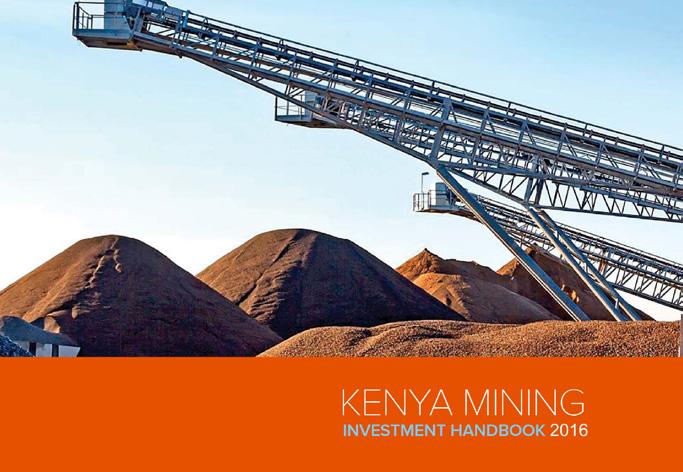
Continued on next page...
LIGHTWEIGHT NEWS - SPRING 2024
From the Desk of Your Technical Consultant
Historic Vermiculite Production Levels in Kenya

Sources such as the Kenya National Bureau of Statistics, BGS, and some of the USGS Mineral Year Books quote Kenyan vermiculite production as relatively variable over the last couple of decades, although typically they tend to be between 300 to 500 metric tonnes per annum, with an average circa 400 tpa. It will be interesting to see if this changes in the coming years!
USGS Mineral Commodity Summary for Vermiculite (2023 & 2024)
Each January, USGS revises its list of Mineral Commodity Summaries, and vermiculite is, of course, included. Each year, they offer their provisional production estimate for the previous year, but this can change in the next edition when more accurate end-of-year figures, rather than the provisional estimates for that year, are put forward. You can find the January 2024 update HERE and the earlier 2023 figures HERE
The data available is slightly underwhelming, and does not really give the feeling of significant insight into the global production of vermiculite. However, the following abstract from the 2024 update might be of interest to readers:
A company in Brazil continued to develop an additional mine and production facility. The project, which is in Catalao, Goias State, is expected to begin production in 2024 with an initial production capacity of 20,000 tons per year of ore and with production capacity eventually reaching 60,000 tons per year, equalling that of their other operation. The majority of vermiculite from this new location is expected to be super fine grade.
One interesting insight USGS provides is a rolling four-year overview of imports of vermiculite into the USA by origin country, and they summarise this as a very simplified percentage of total imports. One thing of note from
this exercise is that between 2018 and 2022, the U.S. slightly reduced its reliance on imported South African vermiculite and began taking more Brazilian vermiculite, and Zimbabwe vermiculite imports gradually crept out of the “other” category to a fully-fledged 2% of U.S. vermiculite imports.

The British Geological Survey (BGS) is always a bit slower to update their mineral commodity statistics, and they are a little harder to track down on their website, but BGS gives a wider range of producing countries than USGS does, with some data seeming to be common to both sources, but others disagree somewhat! You can search the BGS website HERE (but only after agreeing to their Terms and Conditions and only searching a 10-year span of statistics!).
9
Continued on next page...
LIGHTWEIGHT NEWS - SPRING 2024
From the Desk of Your Technical Consultant
“EPA
Bans Asbestos Nationwide”
THIS is an attention-grabbing headline for a USA Today online news article dated March 18, 2024.
In a historic move, the Environmental Protection Agency has announced a comprehensive ban on asbestos, the deadly carcinogen still used in some parts of the U.S. chemical industry.
This relates to the decision about the final ban on Chrysotile asbestos, the only known form of asbestos currently imported, processed and distributed in the U.S.A., and will have little or no further impact on the U.S. vermiculite industry.
Read the information on the EPA website for a better-informed view of this matter.
EPA Actions to Protect the Public From Exposure to Asbestos
One of EPA’s priorities is to protect the public from adverse health effects of asbestos, a known carcinogen. Actions to protect the public from exposure to asbestos under the Toxic Substances Control Act (TSCA) include the following:
• In March 2024, EPA finalized the risk management rule for chrysotile asbestos. The rule prohibits ongoing uses of the only known form of asbestos currently imported, processed and distributed in the U.S., and will protect people from lung cancer, mesothelioma, ovarian cancer, laryngeal cancer and other health problems caused by asbestos exposure.
The Role of Vermiculite as a Process Media for the Production of Pest Control Agents
Q-fly don’t bother me: SA releases one billion sterile fruit flies
By
Matthew Ward Agius, a science writer for Cosmos Magazine. Jan 5, 2024.
South Australia has now dispersed 1 billion sterile Queensland fruit flies into its Riverland fruit-growing region in response to an outbreak of the destructive citrus pest. Bactrocera tryoni, commonly called Queensland fruit fly or ‘Q-fly,’ is found across Australia’s northern tropics and east coast. It is less commonly found in South Australia and Western Australia, though outbreaks have been known to occur.

South Australia has strict biosecurity laws and polices the importation of certain fresh food products from outside its borders. The state’s citrus-growing Riverland region bordering the Murray River is experiencing 47 Q-fly outbreaks. To combat this, the state’s 8-year-old Sterile Insect Technology facility based in Port Augusta has now neutered and released 1 billion male fruit flies into the region. This process will continue until mid-February, with around 40 million sterile files being reared weekly.
10
Continued on next page...
A Queensland fruit fly. Credit: Chloe Johnson / PIRSA.
LIGHTWEIGHT NEWS - SPRING 2024
From the Desk of Your Technical Consultant
A Case of X-ray Extermination
As with other efforts to eradicate pest species, the premise of insect sterilization is to introduce numerous individuals of a target species that can’t produce viable offspring. The aim is for sterile males to outnumber their wild counterparts. By mating with wild females, the populations of Q-fly, which have short lifespans of under two months, should rapidly decrease.
The sterilization process is one of the final steps used by agricultural authorities when rearing its candidate males, whereby eggs collected in a secure facility are left to hatch into larvae (or maggots) on special tray towers, where they will feed for about a week. They are then harvested and bagged with vermiculite to provide a medium where the maggots harden their skin and transition into their pupal form.
In these dark-colored, hardened stages, the pupae are separated from the vermiculite medium and exposed to X-rays to sterilize them before being shipped out to hatch and distributed in the environment.
South Australia’s Department of Primary Industries and Regions (PIRSA) is responsible for the state’s sterile fly program and anticipates continuing the release of these specimens until mid-February. PIRSA estimates the outbreak will end on March 20.
Read more HERE.
Port of Maputo Reports Record Volume for 2023 – And Some of That Was Shipments of Vermiculite!
January 16, 2024. By:
Irma Venter. Creamer Media Senior Deputy Editor.

The Maputo Port Development Company (MPDC) says the Port of Maputo achieved a record volume of 31.2-million tons in 2023, up 16% over the previous year.
MPDC is a public-private partnership between State-owned Mozambican Railway Company (Caminhos de Ferro de Moçambique, or CFM) and Portus Indico, comprising of JSE-listed Grindrod, DP World and local company Mozambique Gestore.
The record volumes at Maputo come as South Africa’s State-owned Transnet group battles inefficiencies at its ports and railway lines.
Of the 31.2 million tons handled at Maputo, about 25 million tons were made up of various ores, including chromium, ferrochrome, magnetite, coal, phosphate, vanadium, titanium, copper, vermiculite, among others.
Read more HERE and HERE.
11
Continued on next page... LIGHTWEIGHT NEWS - SPRING 2024
From the Desk of Your Technical Consultant
Uganda Clarifies Minimum Tin Export Grade, and Announces Likely Future Purity Standards to Come for Vermiculite, Tantalum, and Tungsten
Dr. Ruth Nankabirwa Ssentamu; Uganda’s Minister of Energy and Mineral Development
On December 22, 2023 Uganda’s Minister of Energy and Mineral Development Dr. Ruth Nankabirwa Ssentamu signed a new statutory instrument that clarified the minimum purity of tin exports as 99.85%, emphasizing requirements for local value addition. Previous regulations had stipulated a minimum grade ranging between 67% and 70%.
The new legislation provides much-needed clarity following the ban placed on the export of unprocessed minerals and concentrates and the Government’s demand for local value addition.
Uganda is a small producer, with mine production of tin less than 1,000 tons per annum, and as of December 2023 no refined tin production. The country has a history of artisanal production and there are only three mechanized tin projects underway, including the Woodcross Resources’ Ntungamo and Isingiro exploration projects. Announcing the statutory changes, Dr. Nankabirwa

Q: How long have you been a member of TVA, and why did you join?
I became fascinated with the production of vermiculite through two antiquated "Mantoc" furnaces, so to date, I have been involved with vermiculite for some 50 years!
Q: Tell us about your company and what you do in your current position.
A: I retired from Dupré in 2018; however, itchy feet and a realization that my life's work was my biggest interest, I decided to start my own consultancy business without great expectations, it has to be said. Within weeks I was called upon to advise a miner in China, a country that I know well. Then along came COVID, just three months after my return from Wuhan, of all places! Since then, the demand for my services has been a constant in my life.
Q: What is the biggest industry-related change or challenge you've seen over the years, and what have you done to overcome it?
A: The biggest change, I can say, has been the demand by end users for tighter and tighter quality demands, which goes all the way down the line back to miners. The biggest challenge we face today is cost increase and competition from other products. While supply from been a thorny issue, it has not been a
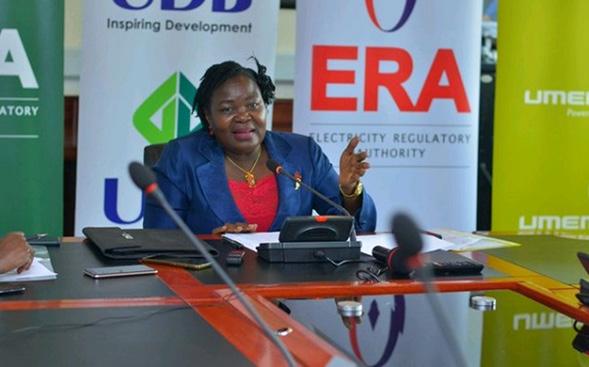
commented Uganda “will make much more money in this processed tin than the semi-processed tin.” The Minister highlighted the recent completion of Woodcross Resources’ tin refining facility at Mbarara, as an example of the local value addition to tin production.
The initiative aligns with a wider policy directive from the President of Uganda, Yoweri Museveni, to cease the export of unprocessed minerals. Dr. Nankabirwa stated that similar purity standards will soon be established for other minerals, including vermiculite, tantalum, and tungsten.
Read more HERE, HERE and HERE.
A: My membership with TVA goes way, way back, maybe over 40 years. I served as a Director of TVA and often attended annual meetings. I joined TVA as vermiculite became my focus at Dupré, and my vision was to become totally immersed in vermiculite and its applications. Joining TVA allowed me to network with like-minded people.
Q: What do you enjoy most about your membership with TVA?
A: The newsletter and Mike Darling’s contribution is always a good read. The annual meetings are a highlight and are very informative.
Q: Tell us a fun fact about yourself.
A: Well, it’s not so much fun for the family, but my son Robert and I (who is now General Manager at Dupré Minerals Ltd) are not
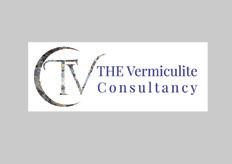
In future issues of TVA's Lightweight News newsletter, we want to highlight our amazing members. Spotlight your company and share your experience in the industry!
Do you want to be featured? Simply click the button below and fill out our interview survey. You can also include a headshot and/ or your company logo, please email Communications Associate Matthew Zemba at commassoc@vermiculite.org
12
on next page...
Continued
Feature Yourself in Lightweight News!
Click Here to complete our interview survey. LIGHTWEIGHT NEWS - SUMMER 2023 Member Spotlight Andrew Baylay, The Vermiculite Consultancy Ltd Q: How long have you been in the industry, and why did you get into this industry? A: Being a "Stokie" from Stoke on Trent in the United Kingdom, I was brought up in the world-famous center of ceramics. I studied ceramics, heavy clays and hightemperature steel plant refractories. My working life began as a laboratory technician at the age of 16 at a local brickworks that produced building bricks, Fireclay bricks and High-Temperature Bauxite bricks for steel ladle linings. A move of employer some 10 years later (1974) took me to what is now Dupré Minerals Ltd (previously Hoben Davis Ltd) as Assistant General Manager. It was here that
LIGHTWEIGHT NEWS - SPRING 2024
From the Desk of Your Technical Consultant
Swedish Vermiculite
Sweden is not a country you normally associate with vermiculite occurrences, but there are some rather rare, and rather beautiful examples of vermiculite crystals found in and around the iron ore mine at Malmberget, Gällivare, Norrbotten County, in Sweden.
Malmberget is known as a major site for extracting iron ore (magnetite and hematite) from deep mines by the major Swedish mining company LKAB. Iron ore mining started in 1741 at the Illuvaara Mountain, later known as Gällivare Malmberg and eventually just Malmberget. The first train which transported iron ore was loaded in 1888. This was the beginning of the great iron ore rush which would change the entire area of Northern Lapland.
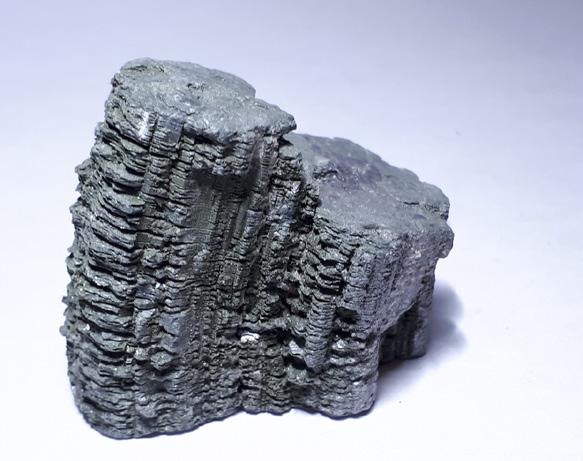

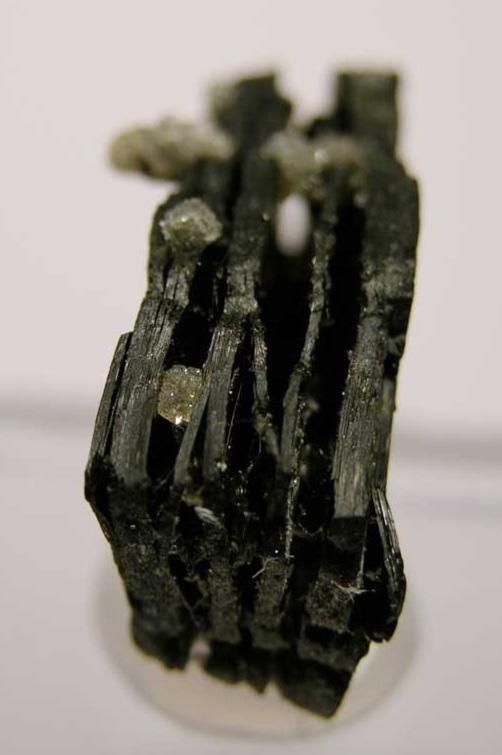
In this locality, vermiculite crystals normally found are associated with the tectosilicate zeolite minerals Stellerite and Stilbite. Three rather wonderful examples of these are reproduced below from mindat.org.
Sources: HERE and HERE
13
LIGHTWEIGHT NEWS - SPRING 2024
Technical Papers
a listing of literature about the use of vermiculite by Mike Darling
Preparation of vermiculite/g-C N /TiO composites and their degradation of dye wastewater or Click Here
Authors: Fu Qiaofang, Tan Fangyu, & Wu Ying.
Published in: Polyhedron. Volume 247, January 1, 2024.
Abstract: The vermiculite g/C3N4/TiO2 composites were prepared from melamine, TiO2 and vermiculite by gel- aerogel method. The structure, morphology, and optical properties of the catalysts were characterized and analyzed using XRD, SEM, UV–Vis DRS, PL, XPS, and N2 adsorption–desorption curves, which proved that the composites were successfully prepared. It was found that the best catalyst effect was achieved when the calcination temperature was 200 °C, the calcination time was 3 h, the TiO2 mass fraction was 35 wt %, and the amount of catalyst added was 75 mg. The degradation rate of methylene blue (MB) could reach 99.33%.Composites are good at compensating for the variability of individual materials in various aspects, such as increasing their surface area, decreasing their carrier loading rate, improving their light energy utilization, and enhancing their resistance. And vermiculite /g-C3N4/ TiO2 still has good degradation effect on MB after four times of recycling, which proves the reusability and stability of vermiculite/g-C3N4/TiO2 and provides an excellent idea for dye degradation.
Plasma-Catalytic Decomposition of 2, 4-Dichlorophenol in a Dielectric Barrier Discharge with a Vermiculite ZiO2 Composite
Authors: Grigoriy I. Gusev, Andrey A. Gushchin, Vladimir I. Grinevich, Ekaterina M. Baburina, Ekaterina S. Severgina, & Natalya E. Gordina.
Published in: Advances in Chemical Engineering and Science, Vol.13, No.4, October 2023.
Abstract: The paper presents comparative kinetic characteristics of the decomposition of 2, 4-dichlorophenol in a dielectric barrier discharge and a combined plasmacatalytic process. Vermiculite containing 5% zirconium was used as a catalyst. The destruction processes of 2, 4-DCP proceed efficiently, the degree of decomposition increases in the combined plasma-catalytic process by a factor of 1.33 and reaches 80%. The experimental results were processed according to the first-order kinetic law (R2 > 0.97), according to which the effective constants (0.36 ± 0.04) and (0.51 ± 0.03) s-1 and the decomposition rates of 2, 4-DCP (106 and 123 μmol/l·s) when treating model solutions without a catalyst and with vermiculite + Zr 5%, respectively, and the energy costs are 0.012 and 0.017 molecules/100eV. The main decomposition products present in the solution have been determined to be carboxylic acids, aldehydes, the contribution of which does not exceed 2%, as well as chloride ions, and in the gas phase they are carbon dioxide and molecular chlorine (the share of which does not exceed 1.5% of total chlorine content in the system).
Development of an Electric Furnace for Heat Treatment of Vermiculite with Firing Module Curved Surfaces
Authors: A. I. Nizhegorodov, A. N. Gavrilin & B. B. Moizes
Published in: Heat Engineering, Volume 63. Published October 7, 2023.
Abstract: A new modification of electric modular firing furnaces for heat treatment of vermiculite with firing module curved surfaces is considered. The basic designs of such furnaces consist of three or two flat modules installed at an angle to each other for pouring material from one module to another and firing in a thermal field created by electric heaters. With the same length of curved module refractory base, the heat treatment time increases by 23% and the exit velocity of the expanded vermiculite grains decreases to 0, 6 – 0, 65 m/sec, which is enough so that all particles, regardless of size, do not settle at the module outlet and do not form blockages. Increasing firing duration does not reduce furnace productivity, but it reduces the specific energy content of the process. Energy consumption and energy intensity of vermiculite firing are reduced by 13 %, but the module design is not optimal. Optimization of the size and shape of modules to increase furnace unit energy efficiency is a task for subsequent research.
14
Continued on next page...
3 4 2 LIGHTWEIGHT NEWS - SPRING 2024
Technical Papers
a listing of literature about the use of vermiculite by Mike Darling
Effective stabilization of heavy metals in solid waste and sludge pyrolysis using intercalated-exfoliated modified vermiculite: Experiment and simulation study or Click Here
Authors: Yuxuan Yang, Zhaoping Zhong, Baosheng Jin, Bo Zhang, Haoran Du, Qian Li, Xiang Zheng, Renzhi Qi, Pengkun Ren, & Zhaoying Li.
Published in: Waste Management. Volume 178, April 15, 2024.
The removal of Rhodamine B from aqueous solution using manganese oxide modified vermiculite
Authors: Livingstone Chauke, Emmanuel Christopher Umejuru, Rebecca Oyedoyin Adeeyo, & Joshua Nosa Edokpay.
Published in: South African Journal of Chemical Engineering. Volume 47, January 2024.
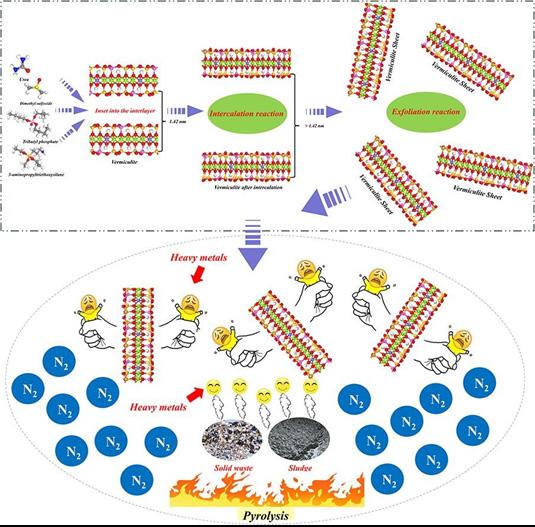
Abstract: Pyrolysis is effective in reducing the volume of solid waste and sludge, and produces less pollutants than incineration and landfill, but the process still suffers from heavy metal pollution. Four types of intercalated-exfoliated modified vermiculite (UIV, DIV, TIV and 3IV) were prepared using urea, dimethylsulfoxide, tributyl phosphate and 3-aminopropyltriethoxysilane as intercalators for the control of Cd, Cr, Cu, Pb and Zn in municipal sewage sludge (MSL), paper mill sludge (PML), municipal domestic waste (MWA) and aged refuse (AFE). The larger the interlayer spacing of the vermiculite, the more favorable the retention of heavy metals. 3IV was the most effective additive, with an average retention of more than 75% of all heavy metals at 450 oC for the four raw materials. Cr, Cu, Pb and Zn were all at low potential ecological risk (Pr), while Cd was moderate or considerable Pr, and the addition of 3IV reduced the Pr. Distribution of intercalators between vermiculite interlayers was haphazard, and interlayer spacing results were close to those of the experiment (except for tributyl phosphate). The reactive electrons mainly flowed from the Highest Occupied Molecular Orbital (HOMO) of vermiculite flakes to the Lower Unoccupied Molecular Orbital (LUMO) of heavy metal chlorides. In contrast, the reactive electrons mostly flowed from the HOMO of heavy metal oxides to the LUMO of vermiculite flakes. Heavy metal oxides were more readily adsorbed on vermiculite flakes than heavy metal chlorides, and the adsorption capacity of Cr and Zn was stronger than that of Cd, Pb and Cu.
Abstract: In this study, we prepared and used manganese oxide-modified vermiculite (Mn–MV) as an adsorbent to sequester Rhodamine B (RhB) dye from aqueous solution. Mn–MV was characterized using a Fourier transform infrared (FT-IR) spectrometer, XRF spectrometry and scanning electron microscope (SEM) to identify the functional groups, components and morphology of the sorbent. Analysis of the adsorbent’s functional groups revealed the presence of O–H, C–H, C=C, C–O, and C–O–H groups. The experiments were conducted using a batch adsorption procedure. The optimal removal of Rhodamine B (RhB) was achieved with a dosage of 1.75 g of Mn–MV, a pH of 10, and a duration of 45 min. The study on the effect of temperature demonstrated that an increase in temperature favored the removal of RhB using Mn–MV. The data from the kinetic and isotherm models were best described by the pseudosecond-order and Langmuir models. The thermodynamic parameters, ∆H = 6.32 kJ/mol and ∆S = 82.12 J/mol/K, indicate that the adsorption process is endothermic and spontaneous. These results indicate that vermiculite clay has the potential to be a cost-effective adsorbent for the removal of RhB dye.
Continued on next page...
15
LIGHTWEIGHT NEWS - SPRING 2024
Technical Papers
NaY Zeolite Synthesis from Vermiculite and Modification with Surfactant
Authors: Thiago Rodrigo Barbosa Barros, Thianne Silva Batista Barbosa, & Meiry Gláucia Freire Rodrigues.
Published in: Catalysis Research 2023, Volume 3, Issue 4, December 26, 2023
Abstract: This work focuses on preparing NaY zeolite using alternative sources of silica and modifying the zeolite with the surfactant cetyltrimethylammonium bromide. Two different hydrothermal synthesis routes were employed: the conventional method using sodium silicate as the silica source, and the other is a sustainable approach using vermiculite clay as the silica source. In traditional zeolite synthesis, sodium silicate is often used as the source of silica. However, the vermiculite was subjected to an acid treatment, followed by a primary treatment to obtain silica. Using the ion exchange method, the NaY zeolite was modified by an organic surfactant CTABr. Based on the various characterization techniques, it was possible to verify the obtaining of NaY zeolite through the conventional and sustainable routes, in which the structural properties were maintained. They used the sustainable path to synthesize NaY zeolite, which allowed for obtaining a material with low synthesis cost and properties similar to those synthesized conventionally. The structures of the NaY zeolites were maintained after the modification process with the surfactant Cetyltrimethylammonium Bromide (CTABr), demonstrating the structural stability of the zeolites and the efficiency of the modification process.

a listing of literature about the use of vermiculite by Mike Darling Continued on
Parameter control in synthesis of Vermiculite-CaCl2 composite materials for thermochemical adsorption heat storage or Click Here
Authors: Yong Zhang, Ziwei Chen, Yanan Zhang, Yuehong Su, & Saffa Riffat.
Published in: Energy, Volume 291, March 15, 2024.
Abstract: This study utilized vermiculite as a matrix to explore various impregnation methods for synthesizing vermiculite-CaCl2 composite materials (VCMs), focusing on the impact of these methods on the performance of VCMs as thermochemical materials. Results indicate that alternative impregnation methods (e.g., multi-step, vacuum, high pressure, and high temperature) reduce VCM porosity compared to single impregnation, resulting in higher salt content as confirmed by CaCl2 content tests. Multi-step impregnation yields VCMs with an exceptional salt content of 81.37 wt%, surpassing the highest literature value (68 wt%) and the control group VCM-s (51 wt%). Vacuum impregnation notably increases salt penetration, leading to VCM-vac having the lowest porosity. However, this reduced porosity results in lower hydration and dehydration rates. Notably, VCM-vac exhibits the highest energy storage density of 2.05 GJ/m³, which is approximately three times the reported literature values and 1.5 times greater than the study’s control group VCM-s. It also exceeds the CaCl2-rich VCM-m by 0.2 GJ/m³. It also demonstrates superior cyclic stability, with most CaCl2 remaining internalized, minimizing agglomeration and CaCl2 loss. The energy consumption for vacuum impregnation is estimated at 3.51 kWh/kg (salt), indicating relatively low energy usage. The findings indicate vacuum impregnation emerges as a preferred method for synthesizing thermochemical composite materials.
16
next page...
LIGHTWEIGHT NEWS - SPRING 2024
Technical Papers
a listing of literature about the use of vermiculite by Mike Darling
Differential dissolution of interlayer, octahedral and tetrahedral cations of vermiculite in oxalic acid
Authors: Yu Zhang; Hongjuan Sun; Tongjiang Peng; Liming Luo; & Li Zeng.
Published in: Clay Minerals (2023) 58 (3).
October 19, 2023.
Abstract: Physical and/or chemical changes such as refinement, component dissolution, exchange/adsorption, structural evolution and recombination of phyllosilicate minerals occur continuously in a naturally weakly acidic water environment. To compare the differential dissolution of cations that occupy various sites in vermiculite, trioctahedral vermiculite was dissolved in various concentrations of oxalate for 24 h and in 0.2 M oxalate for various durations. The concentration of ions in the leaching solution and the phase, structure and morphology of the original samples and acid-leached samples were analyzed. Structural analysis showed that the 001 reflections of vermiculite gradually shifted to a higher angle and eventually disappeared after the dissolution of interlayer cations caused by acid leaching. The amount and rate of dissolution of each cation in the vermiculite showed that the octahedral cation Mg2+ is more soluble than Fe2+ and Fe3+. The dissolution rates of Al3+, Mg2+ and Ca2+ were greatest in the first 4 h and then decreased gradually. Amorphous silicon dioxide and calcium oxalate were formed during acid leaching, and calcium oxalate was formed in the first 4 h. After leaching with oxalate for various periods, the cation-exchange capacity (CEC) of the samples first increased and then decreased. Micromorphology analysis showed that the acid erosion process started from the edges. The results of this work contribute to our understanding of many natural geochemical processes, and they will be useful for several applications such as soil improvement, ecological restoration and environmental protection.
Synthesis of Guanine/Vermiculite Two-Dimensional Nanocomposites for Wireless Humidity Sensing in Nut Storage Environment or Click Here
Authors: Qiqi Hong, Lan Zhao, Fengcai Lin, Ningning Tan, Xinda You, Beili Lu, Biao Huang, Jianhua Lv, Yandan Chen, & Lirong Tang.
Published in: ACS Appl. Mater. Interfaces December 6, 2023.
Abstract: Two-dimensional (2D) nanostructures have the advantages of high specific surface area, easy surface functionalization, abundant active sites, and good compatibility with device integration and can be assembled into three-dimensional structures, which are key to the development of high-performance gas sensors. In this study, 2D vermiculite (VMT) nanosheets and guanine (G), two renewable resources with unique chemical structures, were organically combined to fully use the specificity of their molecular structures and functional activities. Driven by the regulation of 2D VMT nanosheets, guanine/vermiculite (G/VMT)-based 2D nanocomposites with controllable pore structure, multiple binding sites, and unobstructed mass transfer were designed and synthesized. The G/ VMT nanocomposite material was used as a quartz crystal microbalance (QCM) electrode-sensitive film material to build a QCM-based humidity sensor. G/VMT-based QCM humidity sensor had good logarithmic linear relation (0.9971), high sensitivity (24.49 Hz/% relative humidity), low hysteresis (1.75% RH), fast response/recovery time (39/6 s), and good stability. Furthermore, with a QCM sensor and a specially designed wireless circuit, a wireless humidity detection system transmitting via Wi-Fi allows real-time monitoring of nut storage. This study presents an environmentally friendly, high-performance, miniature 2D nanocomposite sensor strategy for real-time monitoring.
Continued on next page...
17
LIGHTWEIGHT NEWS - SPRING 2024
Technical Papers
a listing of literature about the use of vermiculite by Mike Darling
A novel method to improve anti-aging properties of SBS modified bitumen by zinc oxide/expanded vermiculite composite: Influence of zinc oxide particle loadings or Click Here
Authors: Yao Luo, Henglong Zhang, Haihui Duan, Panfeng Du, & Jiawen Cao.
Published in: Construction and Building Materials. Volume 408, December 8, 2023.
Abstract: Styrene-butadiene-styrene copolymer modified bitumen (SBSMB) has been commonly used in pavement construction for its excellent performance. However, during construction and service life, SBSMB is inevitably subjected to thermal-oxidative or ultraviolet aging as a result of factors in the environment like heat, light and oxygen. This study investigated the effects of zinc oxide/expanded vermiculite composite (Z/E) on SBSMB, in particular the effects of Z/E with different zinc oxide (ZnO) particle loadings on SBSMB. And Z/E with different ZnO particle loadings were prepared and characterized by X-ray fluorescence spectrometer, field emission scanning electron microscope, UV–Visible spectrometer and Fourier transform infrared spectrometer tests. To age bitumen samples, thin film oven test, pressure aging vessel and ultraviolet aging tests were used. Eventually, the effects of Z/E with various ZnO particle loadings on the storage stability, physical, rheological and anti-aging properties of SBSMB were investigated. According to the results, Z/E with different ZnO particle loadings are successfully prepared. There are uniform ZnO particles on the surface of expanded vermiculite and ZnO particle loadings are increased with the concentration of the ZnO precursor solution. Furthermore, the hightemperature performance of SBSMB is enhanced, but the low-temperature performance is slightly affected by Z/E. Whatever the aging mode, the introduction of Z/E can obviously reduce the viscosity aging index, softening point increment, complex modulus aging index and increase phase angle aging index of SBSMB, demonstrating that the aging resistance of SBSMB are significantly enhanced. It was determined that SBSMB with 29.5 wt %Z/E had the best aging resistance.
Overcoming the permeability-selectivity challenge in water purification using twodimensional cobalt-functionalized vermiculite membrane or Click Here
Authors: Mengtao Tian, Yi Liu, Shaoze Zhang, Can Yu, Kostya (Ken) Ostrikov & Zhenghua Zhang.
Published in: Nature Communications, 2024, Volume 15, Article no: 391.
Abstract: Clean water and sanitation are major global challenges highlighted by the UN Sustainable Development Goals. Water treatment using energy-efficient membrane technologies is one of the most promising solutions. Despite decades of research, the membrane permeabilityselectivity trade-off remains the major challenge for synthetic membranes. To overcome this challenge, here we develop a two-dimensional cobalt-functionalized vermiculite membrane (Co@ VMT), which innovatively combines the properties of membrane filtration and nanoconfinement catalysis. The Co@VMT membrane demonstrates a high water permeance of 122.4 L·m−2·h−1·bar−1, which is two orders of magnitude higher than that of the VMT membrane (1.1 L·m−2·h−1·bar−1). Moreover, the Co@VMT membrane is applied as a nanofluidic advanced oxidation process platform to activate peroxymonosulfate (PMS) for degradation of several organic pollutants (dyes, pharmaceuticals, and phenols) and shows excellent degradation performance (~100%) and stability (for over 107 h) even in real-world water matrices. Importantly, safe and non-toxic effluent water quality is ensured by the Co@VMT membrane/PMS system without brine, which is totally different from the molecular sieving-based VMT membrane with the concentrated pollutants remaining in the brine. This work can serve as a generic design blueprint for the development of diverse nanofluidic catalytic membranes to overcome the persistent membrane permeabilityselectivity issue in water purification.
Continued on next page...
18
LIGHTWEIGHT NEWS - SPRING 2024
Technical Papers
a listing of literature about the use of vermiculite by Mike Darling
Effect of mineralogical characteristics evolution of vermiculite upon thermal and chemical expansions on its adsorption behavior for aqueous Pb(II) removal or Click Here
Authors: Lei Hou, Baolin Xing, Hui Guo, Huihui Zeng, Song Cheng, Mingliang Meng, Xiaoxiao Qu, Alejandro Valdivieso López, Chuanxiang Zhang, & Yijun Cao.
Published in: Powder Technology Volume 430, December 1, 2023.
Abstract: Vermiculite undergoes significant changes in mineralogical characteristics upon chemical (with H2O2) and thermal (roasting) expansions, resulting in a marked impact on its adsorption behavior toward Pb(II) removal. Both chemical and thermal expansions exfoliated the tightly-stacked bulk structure of raw vermiculite into ultra-thin sheets and built abundantly nanoporous channels in the lamellar region, offering sufficient adsorption sites. Meanwhile, the surface properties of hydrophilicity and negative charge in raw vermiculite remain unaltered during expansions, thus enabling an enhanced adsorption capacity through electrostatic attraction. However, severe loss of cation exchange capacity and structural hydroxyl groups due to thermal expansion damaged mixed crystal phases in vermiculite and hydrophlogopite, leading to the poorer Pb(II) removal capability. The results demonstrate that the favorable influence of chemical expansion in raw vermiculite for Pb(II) removal is attributed to enhanced cation exchange within the interlayer, functional groups of structural hydroxyl and siloxane, and negative surface charge on hydrophilic surface.
Smart Energy Clays: Chemical Vapor Deposition of PEDOT in Expanded Vermiculite Blocks for Electrochemical Energy Storage or Click Here
Authors: Xiaoxiao Wang, Pengzhen Wang, Weiliang Tian, Hongling Bu, & Kewei Zhang.
Published in: ACS Sustainable Chem. Eng. 2023, (American Chemical Society). November 27, 2023.
Abstract: With rapid development of sustainable energy storage systems and intelligent energy supply equipment, supercapacitors have attracted wide attention while still suffering from low specific capacitance, poor kinetic diffusion, and charge transfer. Here, we demonstrate the concept of integrating conductive polymer poly (3,4-ethylenedioxythiophene) (PEDOT) into insulation voids in expanded vermiculite blocks, achieving PEDOT-intercalated vermiculite electrodes for pseudocapacitive energy storage. The electrodes show rapid kinetic diffusion and charge transfer as well as high areal specific capacitance of 2592 mF cm–2 at the current density of 3 mA cm–2, surpassing most of the state-of-the-art electrodes for supercapacitors. The prepared electrodes were assembled into a symmetrical supercapacitor which shows a specific capacitance of 412.8 mF cm–2 at a current density of 2 mA cm–2 with a high energy density of 30.3 μW h cm–2 at a high power density of 3001.8 μW cm–2 This work realizes the preparation of electrochemical energy storage electrode materials on insulating layer minerals, which is a fruitful tactic and opens the door to the creation of more supercapacitor electrodes.

19
Continued on next page...
LIGHTWEIGHT NEWS - SPRING 2024
Technical Papers
a listing of literature about the use of vermiculite by Mike Darling
Utilization of vermiculite particles in the enhancement of the ilmenite based oil well cement properties or Click Here
Authors: Abdulmalek Ahmed, Fahad Khan, & Salaheldin Elkatatny.
Published in: Geoenergy Science and Engineering. Volume 231, Part A, December 2023.
Abstract: Cementing the wellbore is one of the key jobs required for production from the reservoir. It is an essential part of the wellbore that supports the casing string and provides isolation between production and non-production zones. The challenging in situ conditions of reservoir can cause damage to the cement slurry. Hence, it is important to study various properties of this slurry under such conditions. The cement slurry should provide good strength, lower density variation, lower porosity and permeability and better rheological properties. The present study investigates the effect of vermiculite particles on ilmenite based Saudi class G cement. The cement powder, vermiculite and ilmenite were characterized using XRF analysis, particle size distribution and FESEM analysis. The performance of vermiculite as an additive was tested for different concentrations (0.25%, 0.50%, 1.0%, 2.0%, and 4.0% BWOC) and compared with base cement having no vermiculite content. The test includes rheological properties, compressive and tensile strength, elastic properties like Young’s modulus and poison’s ratio, density variation, and petrophysical properties like porosity and permeability calculation. It was observed from the results that at 2% BWOC addition of vermiculite, the performance of slurry was optimized for all the tests. At 2% BWOC addition of vermiculite, the yield point and gel strength were increased to maximum value while the porosity and permeability were found to be least. The compressive strength was increased by almost 10% and Young’s modulus was reduced by nearly 44%. This study investigated for the first time the possibility of vermiculite to improve the ilmeniteweighted oil well cement and its experimental results emphasized the capability of vermiculite particles to enhance the properties of the ilmenite-based cement slurry and can be used as an additive.
Effect of vermiculite feed additive on the chemical, mineral, and amino acid compositions of quail meat or Click Here
Authors: Gulbanu Apdraim, Nurzhan Sarsembayeva, & Bozena Lozowicka.
Published in: Vet World. December 6, 2023.
Abstract: Background and Aim: Poultry farming plays a significant role in providing the population with highquality and cheap meat products. The development and success of this industry depend on the proper use of available feed. As a rule, feed additives should compensate for missing elements in livestock diets. This study investigated the effects of vermiculite feed additives on the chemical, amino acid, and mineral compositions of quail meat. Materials and Methods: Texas Quail meat breed birds were randomly divided into three groups (35 heads each). Group I served as the control group, in which the birds were fed a standard diet without any supplements. The diet of Group II was supplemented with 3% vermiculite feed additive, whereas Group III received 5% vermiculite. The experiment was conducted over 120 days. Results: Quails in the experimental groups contained less moisture, had more ash and protein, and were richer in calories in terms of energy value. In terms of mineral composition, the calcium concentrations were 9.9% and 16.5% higher in the in the Group I and II, respectively. Furthermore, the highest percentages of nonessential and essential amino acids were found in the 5% vermiculite group. In the meat of quails that received 5% vermiculite, cadmium and lead salt levels were 20%–25% lower than those in the control variant.
Conclusion: The results of our analyses confirmed that meeting the mineral requirements of quails improves animal productivity and meat product quality. Vermiculite as a feed additive improved the chemical, mineral, and amino acid compositions of quail meat when it was added to up to 5% of the feed dry matter. These results will help to improve the feed base of the poultry industry in the Republic of Kazakhstan.
Continued on next page...
20
LIGHTWEIGHT NEWS - SPRING 2024
Technical Papers
a listing of literature about the use of vermiculite by Mike Darling
Hybrid green composites of PLA incorporated with upcycled waste cellulose and vermiculite or Click Here
Authors: Gizem Ariturk, Cagla Girisken, Kaan Bilge, Ceren Yargici Kovanci, Yusuf Ziya Menceloglu, & Senem Avaz Seven
Published in: European Polymer Journal. Volume 203, January 19, 2024.
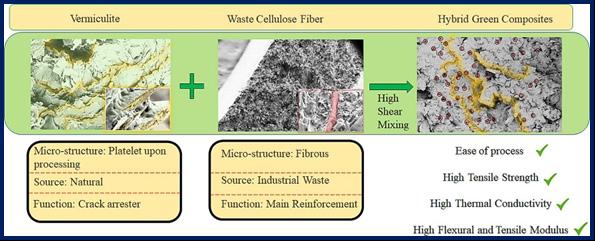
Abstract: The work aims to utilize a hybridization method where vermiculite and waste cellulose fibers are embedded inside bio-based PLA to manufacture green composites with superior characteristic properties such as improved thermal conductivity, enhanced processability, and increased mechanical strength in the resulting green composites. The potential of polymeric composites for emerging greener material development is very high. Originating from this point, this article reports the experimental findings on a hybrid composite reinforcement strategy where two types of renewable materials are employed as co-reinforcement agents in a biodegradable polylactic acid (PLA) matrix. Green composite sample manufacturing was performed via high shear mixing (5000 rpm). Composite samples containing waste cellulose fibers (WC), (average diameter: 15 µm) and vermiculite platelets (VC), (average size: 1.4milimeters) as inclusions and a low crystallinity thermoplastic PLA matrix are targeted. Two-phase composites having 10, 20,30 wt% WC, 30 wt% VC, and hybrid composites having 15VC-15WC wt. % and 7.5VC-22.5WC wt. % are manufactured. Composite samples are then tested for their thermal, rheological, and mechanical responses. Thermal analysis suggests that thermal conductivity is improved by 68% for PLA30VC samples and in hybrid composites, thermal conductivity is regulated by WC, while crystallinity is regulated by VC. Rheological measurements suggest both filler materials contribute to the processability of PLA, and hybrid composites are more readily processable than neat PLA at 200 °C. While the tensile strength remains the same in all composites, a 137% increase in E modulus and 127% increase in flexural modulus is achieved with hybrid composites. The damage modes and contribution of both inclusion types to macro and micro fracture mechanisms are discussed in detail. Overall, results suggested that a stronger, easily processable, and thermally more conductive yet stable superior material alternative could only be achieved by the synergistic use of WC fibers and VC platelets.
2D vermiculite nanofiltration membrane with TiO nanoparticles as versatile intercalator for enhanced water purification or Click Here
Authors: Xiaocui Wei, Yanan Liu, Zhao Zhang, Fu Zhao, Zongmei Li, Chunyang Fan, Yuhan Yang, & Zhongyi Jiang.
Published in: Journal of Membrane Science. Volume 695, March 2024.
Abstract: Two-dimensional (2D) materials membranes have gained widespread attention for their unique structure and outstanding separation performance. Herein, we developed a 2D vermiculite nanofiltration (TiO2@VMT) membrane using TiO2 nanoparticles as versatile intercalator. The interlayer spacing of vermiculite nanosheets was tuned from 1.352 ± 0.002 nm to 1.424 ± 0.004 nm. As a result, the optimized TiO2@VMT membrane exhibited high water flux of 261 L m−2 h−1, which was 14 times higher than that of vermiculite membrane, simultaneously showed excellent rejections (>98%) for various organic dyes (molecular weight >374 g mol−1). Due to the photocatalytic degradation ability of TiO2 nanoparticles towards organic foulants, the TiO2@VMT membrane possessed excellent anti-fouling performance, with a flux recovery rate exceeding 90% under UV radiation after three cycles of filtration experiment using oil-in-water emulsion and BSA solution as model foulants. Accordingly, our work may offer a possible route for the development of 2D nanofiltration membrane for efficient water purification.
Continued on next page...
21
2 LIGHTWEIGHT NEWS - SPRING 2024
Technical Papers
a listing of literature about the use of vermiculite by Mike Darling
Self-assembly of Fe-MOF on vermiculite nanosheets with enhanced catalytic activity or Click Here
Authors: Haibin Yang, Junzhen Guo, Liang Chu, Zhi Huang, Zhaohui Liu, Liyan Wang, Zhaokun Wang, Mu Yang, & Ge Wang.
Published in: Applied Clay Science Volume 245, December 1, 2023.
Abstract: Utilizing natural, abundant, and eco-friendly materials to facilitate the industrial application of nano-sized MOF particles is of utmost importance, since these nanoparticles possess high activity but difficult to recovery. Herein, benefiting from the negatively charged vermiculite, dispersed nano-sized Fe-MOF particles were successfully in-situ grown on the surface of vermiculite nanosheets (VNs) via a simple solvothermal method. The construction of the composites improved the exposure of organic dye to active sites, resulting in a remarkable performance of Fe-MOF@ VNs-4 towards photo-Fenton degradation of RhB, with a k value of 0.096 min−1 and an activity of 0.581 mmol g−1 h−1, significantly higher than that of pure VNs and Fe-MOF, surpassing most reported MOF composite catalysts. The excellent adsorption ability of Fe-MOF@VNs, along with the presence of divalent iron in vermiculite, greatly enhanced catalytic performance. Mechanistic investigations revealed that VNs facilitate the separation of photoinduced carriers excited from Fe-MOF, indicating a synergy effect between Fe-MOF and VNs. Overall, this work provides a simple and effective strategy to design large-scale and commercially available catalysts for water treatment, and also offers a promising alternative for the industrial application of nano-sized MOF particles.
An Eco-Friendly Adsorbent Based on Bacterial Cellulose and Vermiculite Composite for Efficient Removal of Methylene Blue and Sulfanilamide or Click Here
Authors: Xiuzhi Bai, Zhongxiang Liu, Pengfei Liu, Yijun Zhang, Linfeng Hu, & Tongchao Su.
Published in: Polymers 2023, 15(10). May 17, 2023.
Abstract: In this work, a novel composite of bacterial cellulose (BC) and expanded vermiculite (EVMT) composite was used to adsorb dyes and antibiotics. The pure BC and BC/EVMT composite were characterized using SEM, FTIR, XRD, XPS and TGA. The BC/EVMT composite exhibited a microporous structure, providing abundant adsorption sites for target pollutants. The adsorption performance of the BC/EVMT composite was investigated for the removal of methylene blue (MB) and sulfanilamide (SA) from an aqueous solution. The adsorption capacity of BC/ENVMT for MB increased with increasing pH, while the adsorption capacity for SA decreased with increasing pH. The equilibrium data were analyzed using the Langmuir and Freundlich isotherms. As a result, the adsorption of MB and SA by the BC/EVMT composite was found to follow the Langmuir isotherm well, indicating a monolayer adsorption process on a homogeneous surface. The maximum adsorption capacity of the BC/EVMT composite was found to be 92.16 mg/g for MB and 71.53 mg/g for SA, respectively. The adsorption kinetics of both MB and SA on the BC/EVMT composite showed significant characteristics of a pseudo-second-order model. Considering the low cost and high efficiency of BC/ EVMT, it is expected to be a promising adsorbent for the removal of dyes and antibiotics from wastewater. Thus, it can serve as a valuable tool in sewage treatment to improve water quality and reduce environmental pollution.
22
LIGHTWEIGHT NEWS - SPRING 2024

Persuasive Leadership: Effective Communication
by Jeff Tippett
In talking with human resource officers, COOs, CEOs and other corporate leaders about areas needing improvement within their organizations, communication almost always bubbles up.
This need is supported in a 2018 Arthur J. Gallagher & Co. study, where about 60 percent of companies say they don’t have a long-term internal communication strategy. Strikingly, though, about half said they wanted to make improving leadership communication a priority.
So organizations see the need, yet often fail to act. And then there are those leaders that don’t value effective communication who will refer to it as a waste of time, an effort to put a focus on “feelings” instead of productivity and ultimately profits. Or they may refer to communication as a soft skill unimportant to a company’s bottom line.
Poor communication with your team members can lead to attrition and difficulty attracting top talent. And given that replacing a worker can cost a company 33 percent of that worker’s annual salary, it will cost you a lot (both in finance and company morale) for unhappy team members to walk away.
However, as the team leader you can change all of this. And it’s not just good for the people on your team; it’s also good for business.
You have the power to change the direction of your organization through effective 1:1 communication. You just need the tools to get you there.
For all the complexities of communication with others, all communication falls into one of four buckets:
• Verbal communication
• Nonverbal communication (including but not limited to eye contact, facial expressions and gestures, posture, body orientation, body language
• Proximity (space and distance)
• Para-linguistic (accent, pitch, volume, speech rate, modulation, and fluency.
• Touch
• Silence
• Personal appearance
• Written communication
• Visual communication
That’s it. You have these four buckets of communication mediums to communicate 1:1 with your team members.
We’re going to focus on one: verbal communication.
In the 1952 publication of Effective Public Relations, Scott Cutlip and Allen Center first introduced the 7 Cs of effective communication. Since its publication, these 7 Cs have become the gold standard for effective, persuasive communication with those around you.
23
Continued on next page... LIGHTWEIGHT NEWS - SPRING 2024
Here are the 7 Cs:
1. Clarity
2. Completeness
3. Correctness
4. Conciseness
5. Concreteness
6. Coherence
7. Courtesy
Now, with these 7 Cs in focus, there are practical ways you can create space for 1:1 communication that will help you persuade those with whom you work. Let’s look at a list of those ways:
• Preparing before the conversation
• Being open
• Showing respect
• Exhibiting compassion and empathy
• Actively listening (including not thinking of your next question instead of being in that moment)
• Having a solution mindset
• Prioritizing subject and topic over emotion
• Always seeking common ground, mutual goals, shared purpose
• Ensuring both sides have equal respect, ability to share thoughts and feelings, and equal opportunities to be heard
• Avoiding distractions
Having first focused on communication enablers, I do think it important to your success to also talk through items that block communication. Take a look at this list:
• Accusing
• Judging
• Insulting
• Using sarcasm
• Globalizing (using words like “always” and “never”)
• Threatening or ordering
• Interrupting
In addition, there are physical barriers like time, environment, comfort, and noise. There are emotional barriers like fear, distrust, and uncertainty.
Finally, with communication enablers in place and a willingness to avoid communication blockers, there’s a path to persuasion:
• Relate
• Move from relating to solving
• When solving offer very specific direction
Once again, we revisit President Johnson. LBJ was attuned to the language that others used. However, collaborative efforts were less of his wheelhouse. In fact, LBJ more often steamrolled those around him during discussions, pressing them to defend their ideas and suggesting they were infantile. The very next day, he would sometimes take their position as his own. In grilling them, he wanted to find who firmly believed what they said and who was flaky in their beliefs. LBJ’s methods in this department will not translate well into the corporate world, but in the throes of Vietnam it made decision-making easier for the president.
If you’re not getting the support of your team you need, don’t have great team camaraderie, or just not hitting your targets, examine your ability to persuade your team through 1:1 communication with you—their leader. I’ve given you the tools to get there.
About the Author:
Jeff Tippett
Jeff Tippett is the international best-selling author of two books, Pixels Are the New Ink and Unleashing Your Superpower: Why Persuasive Communication is the Only Force You Will Ever Need. Speaking to international audiences through keynotes

and seminars, Jeff helps attendees increase their effectiveness, gives them powerful tools to reach their goals, and empowers attendees to positively impact and grow their organizations or businesses.
Social Media Icons
• Within this direction, use concrete language
• Provide space for your listener to process and ask questions
• Empower that listener to take actions need to help you accomplish your vision as their own
Metro Style
In 2014, Jeff founded Targeted Persuasion, an award-winning public affairs + communications firm. He has worked with renowned brands like Airbnb, The National Restaurant Association, The League of Women Voters, The League of Conservation Voters, plus others. Other industry experts have validated Jeff’s work with numerous awards including the prestigious The American Advertising Award.
Jeff is the host of Victory by Association with Jeff Tippett, a podcast that shares the victories of association executives with the world, highlighting the great work done across this country every day.

24
Jefftippett.com
LIGHTWEIGHT NEWS - SPRING 2024
Articles for Lightweight News
TVA is always looking for articles for this newsletter to keep its contents relevant for our members. Articles should range from 200 to 500 words, and photos are welcome. Articles can be about a unique project you’ve been involved with, your company’s community involvement, an industry hot topic, an honor or award—really, anything you think your fellow TVA members would want to read about.
Email articles to TVALightweightNews@gmail.com
Our Mission:
To be the leading vermiculite association in the world and to gather, develop and disseminate accurate and truthful information and regulations, form and encourage collaborations, provide services and promote best practices to members, fund development of new uses and technologies and promote the knowledge and safe use of vermiculite on a global scale.
Lightweight News is an e-publication of The Vermiculite Association. Material in this e-newsletter may be republished with permission of TVA and with proper line credit. Mention of commercial products in this publication is solely for information purposes, and endorsement is not intended by TVA. Material does not directly reflect the opinions or beliefs of the board or staff.
Additional Resources on the TVA Website
TVA’s website, www.vermiculite.org, contains a variety of resources, including these documents about vermiculite:
Vermiculite in the Construction Market
Horticultural Vermiculite
Health, Safety and Environmental Aspects
Crystal Structure of Magnesium Vermiculite
Peat-Lite
Vermiculite Concrete
Vermiculite Data
Vermiculite in the Industrial Sector
The Use of Vermiculite as a Technological Additive in Animal Feedstuffs
Vermiculite Gypsum Plasters
Contact Us:
THE VERMICULITE ASSOCIATION
2207 Forest Hills Drive
Harrisburg, PA 17112
Phone: 717-238-9902
Fax: 717-238-9985
Website: www.vermiculite.org
Staff Contacts:
Executive Director: Lisa Ruggiers tva@vermiculite.org
Director of Communications: Michelle Keyser communications@vermiculite.org
TVA's staff wants you to get the most out of your experience with TVA. We are available to serve you, so please do not hesitate to contact staff with any question or concern that you may have. For a full staff listing, please click here
Collaborating to promote vermiculite. Encouraging and promoting best practices. Dedicated to safety, integrity and honesty.
25
LIGHTWEIGHT NEWS - SPRING 2024



















































